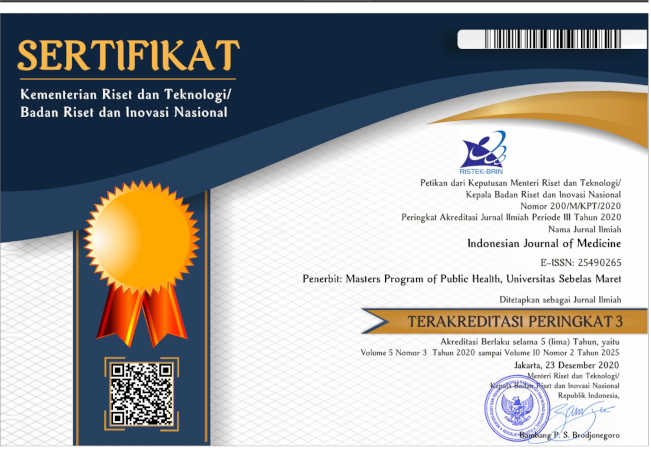Relationship between APO-A, APO-B, and C-reactive Protein with Depression in Epileptic Patients
DOI:
https://doi.org/10.26911/theijmed.2020.5.4.348Abstract
Background: Epilepsy is one of the oldest neurological disease requiring long-term treatment. Long-term use of certain anti-epileptic drugs (AED) will strongly induce cytochrome-P450 (CYP) enzyme resulting increase of homocysteine associated with risk of cerebrovascular disease and depression. The purpose of this study was to determine relationship between serum level of ApoA, ApoB, and C-Reactive Protein (CRP) with depression in epileptic patients receiving AED therapy.
Subjects and Method: Respondents of this cross-sectional study were epileptic outpatients in neurology clinic Dr. Moewardi Hospital, Surakarta receiving AED therapy and met inclusion and exclusion criteria. Depression condition was evaluated by Hamilton Depression Rating Scale (HDRS). Serum level of ApoA, ApoB, and CRP of each respondent were measured from vein blood. Data were analyzed by a multiple linear regression.
Results: There were 51 epileptic patients with proportional ratio between men and women (1.2:1) with age range from 18 to 59 years old. The average length of AED 92.67 months (Mean= 92.67; SD= 91.58). Average of HDRS score was 8.49. Meanwhile, average of ApoA level was 86.14 mg/dL, average of ApoB level was 47.57 mg/dL, and average of CRP level was 0.18 mg/dL. Serum level of ApoA, ApoB, and CRP increased depression (HDRS score) in epileptic patients.
Conclusion: There was a statistically significant relationship between serum level of ApoA, ApoB, and CRP with depressive condition of epileptic patients receiving long-term AED treatment.
Keywords: ApoA, ApoB, C-Reactive Protein, depression, epilepsy
Correspondence: Diah Kurnia Mirawati. Neurology Department of Dr. Moewardi Regional General Hospital/ Medical Faculty of Universitas Sebelas Maret, Indonesia. Email: diahkm@staff.uns.ac.id.
Indonesian Journal of Medicine (2020), 05(04): 282-290
https://doi.org/10.26911/theijmed.2020.05.04.03.
References
Alvarez A, Faccioli J, Guinzbourg M (2013). Endocrine and inflammatory profiles in type 2 diabetic patients with and without major depressive disorder. BMC Res Notes.6:61. doi: 10.1186/-1756-0500-6-61
Brodie MJ, Mintzer S (2013). Enzyme induction with antiepileptic drugs: Cause for concern?, Epilepsia. 54(1): 11-27. doi: 10.1111/j.1528-1167.2012.-03671.x.
Chuang YC, Chuang H(2012). Effects of long-term antiepileptic drug mono-therapy on vascular risk factors and atherosclerosis. Epilepsia. 53:120-8. doi: 10.1111/j.1528-1167.2011.03316.x.
Ebesunun MO, Eruvulobi HU, Olagunju T, Owoeye OA (2012). Elevated plasma homocysteine in association with decreased vitamin B12, folate, sero-tonin, lipids and lipoproteins in depressed patients. Afr J Psychiatry (Johannesbg). 15(1):25-9. doi: 10.43-14/ajpsy.v15i1.3.
Fisher RS, Acevedo C, Arzimanoglou A, Bogacz A, Cross JH, Elger CE, et al. (2014). ILAE official report: a practical clinical definition of epilepsy. Epilepsia. 55(4): 475-82. doi: 10.1111/-epi.12550.
Fordjour PA, Wang Y, Shi Y, Agyemang K, Akinyi M, Zhang Q, et al. (2015). Possible mechanisms of C-reactive protein mediated acute myocardial infarction. EurJour of Pharmacol. 760:72-80. doi: 10.1016/j.ejphar.20-15.04.010.
Getz K (2002). Negative symptoms in tem-poral lobe epilepsy. Am J Psychiatry. 159:644-51. doi: 10.1046/j.1535-75-97.2002.00063.x.
Guyton AC, Hall EJ (2011). Buku Ajar Fisio-logi Kedokteran Edisi 11 (Textbook of Medical Physiology, Edition 11). Jakarta: Penerbit Buku Kedokteran EGC. pp.883-94.
John AMF (2009). Dislipidemia (Dyslipide-mia). Dalam: Sudoyo AW, Setiyohadi B, Alwi I, Simadribata M, Setiati S, editor. Buku Ajar Ilmu Penyakit Dalam Jilid III Edisi V (Textbook of Internal Medicine Volume III Edition V). Jakarta: Interna Publishing.
Kanner AM, Barry JJ, Gilliam F, Hermann B, Meador KJ (2012). Depressive and anxiety disorders in epilepsy: do they differ in their potential to worsen common antiepileptic drug-related adverse events? Epilepsia.53(6):1104-8. doi: 10.1111/j.1528-1167.2012.0348-8.x.
Kim DW, Lee S (2013). Effects of new anti-epileptic drugs on circulatory markers for vascular risk in patients with newly diagnosed epilepsy. Busan: Inter-national League Against Epilepsy.
Lee JJ, Song HS, Hwang YH (2011). Psy-chiatric symptoms and quality of life in patients with drug-refractory epi-lepsy receiving adjunctive levetira-cetam therapy. J Clin Neurol. 17:128-36. doi: 10.3988/jcn.2011.7.3.128.
Octaviana F, Khosama H (2014). Epidemio-logi Epilepsi (Epidemiology of Epilep-sy). Dalam: Kusumastuti K, Guna-dharma S, Kustiowati E, editor. Pedo-man Tata Laksana Epilepsi Edisi V (Guidelines for Epilepsy Management Edition V). Surabaya: Pokdi Epilepsi PP PERDOSSI.
Oh-Young K, Sung-Pa P (2014). Depression and Anxiety in People with Epilepsy. J Neurol. 10(3):175-88. doi: 10.3988/-jcn.2014.10.3.175.
Papakostas GI, Petersen T (2004). Serum folate: vitamin B12, and homocysteine in major depressive disorder, part 2: predictors of relapse during the conti-nuation phase of pharmacotherapy. J Clin Psychiatry. 65:1096-8. doi: 10.-4088/jcp.v65n0811
Philippe L(2016). The Immune System and the Role of Inflammation in Perinatal Depression. Shanghai: Shanghai Ins-titutes for Biological Sciences.1-23.
Poonam NB, Filipi D, Hauser WA (2010). The descriptive epidemiology of epi-lepsy-a review. Epilepsy Res. 85(1):31-45. doi: 10.1016/j.eplepsyres.2009.0-3.003.
Saruwatari J, Ishitsu T, Nakagawa K (2010). Update on the genetic poly-morphisms of drug-metabolizing enzymes in antiepileptic drug therapy. Pharmaceuticals. 3: 2709-32. doi: 10.-3390/ph3082709
Terao T, Nakamura J, Yoshimura R (2000). Relationship between serum choles-terol levels and meta chlorophenyl-piperazine induced cortisol responses in healthy men and women. Psychia-try Res. 96:167-73. doi: 10.1016/s016-5-1781(00)00197-9.
Todorova KS, Velikova VS (2012). The vali-dity of the Hamilton Depression Rating Scale as a screening and diag-nostic instrument for depression in patients with epilepsy. J of IMAB; 18(3):305-7. doi: 10.5272/jimab.201-2183.305.
Waldius G, Jungner I (2006). The Apo B/Apo A-1 ratio: a strong, new risk factor for cardiovascular disease and a target for lipid-lowering therapy. A review of the evidence. Jour Of Int Med. 259:493-519. doi: 10.1111/j.1365-2796.2006.01643.x.











